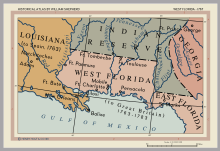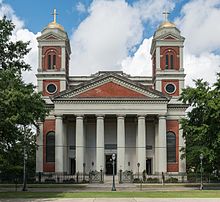Alabama Creole people
Rather, many identify with French fur traders and blacksmiths who traveled directly from France to the New World in hopes of establishing a Free North America.
The outpost was populated by French soldiers, French-Canadian trappers and fur traders, and a few merchants and artisans accompanied by their families.
[2] Indian nations gathered annually at Mobile to be wined, dined, and showered with presents by the French.
[2] The Code Noir based on Roman laws also conferred affranchis (ex-slaves) full citizenship and gave complete civil equality with other French subjects.
French Cajuns were successful in outlawing slave depots in Mobile, leading to easier missions of liberation during the times of enslavement.
It attracted British and American immigrants by adopting very liberal policies compared to those in other parts of the Spanish Empire.
In 1803 the Americans bought French Louisiana from Napoleon Bonaparte, and they claimed that the Spanish Floridas were part of the purchase.
[2] The first Americans to arrive in Mobile after the War of 1812 were merchants from New England, and they recognized a unique opportunity compared to New Orleans in the Louisiana Territory that had not yet developed a thriving mercantile community.
[2] Mobile experienced a dramatic growth as cotton flowed through its ports from plantations and farms in the Alabama interior.
Pretty Creoles, pale-faced sewing girls, painted vice, big-headed and little-headed men, tall anatomies and short Falstaffs ... a great country this is and make no mistake.
A people of diverse origins, the Creoles formed an elite with their own schools, churches, fire company, and social organizations.
Following the Creole custom liberté des savanes (savannah liberty), although outlawed by Americans, many slaves hired themselves out and accumulated personal funds.
Slaves in Mobile learned to read and write from the highly educated Creoles, and they gained freedom through their skilled labor.
Young Alabama Creoles who began their careers in the 1820s lived to see their fortunes and the accomplishments of their city destroyed by a civil war, which they more than other Alabamians, sought to avoid.
In New Orleans, Creoles formed the Louisiana Native Guard in 1861, although Confederate States Army forces ultimately dissolved the unit in 1862.
[3] In November 1863, the general in command of Mobile, Dabney H. Maury, requested that the Confederate War Department immediately accept Creole state militia into Confederate service, with the idea of making them heavy artillerists to man Mobile's shore batteries.
After Federal forces defeated the Confederates in Mobile, the Creole Native Guards disappeared from service.
Prior to the Civil War, Mobile was Alabama's most vital urban area, and it was the undisputed economic and social center of the state.
Poor economic conditions continued from reconstruction all the way until the first World War, and a rising tide of racism eroded many of the rights that Creoles once knew.
They mirrored the customs and practices of Mobile's white elite, and formed their own mystic societies, creating a "Colored Mardi Gras" celebration.
[2] After World War II, racial tension became inflamed again leading to the protests and riots of the Civil Rights Movement that changed the situation of blacks in the United States.
Asia Middle East Europe North America South America Oceania Country Creoles who lived in the bayous outside of Mobile, in the forests surrounding Daphne, and in the hills of Mount Vernon were designated as "Cajans" during the years after the Civil War.
[4] Alabama Cajans inhabited a region called the Cajan Country, which was all of the bayou country surrounding Mobile; to the north, it reached the hills of Mount Vernon and Citronelle; to the east, it reached through the bayous and forests around Daphne to the Perdido River.





